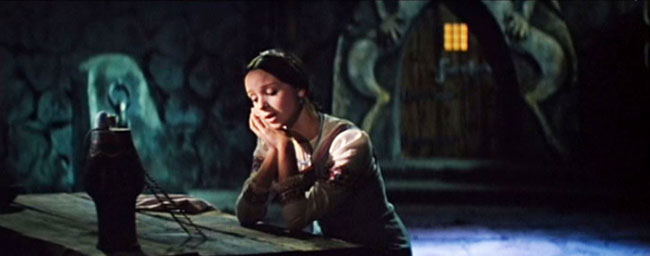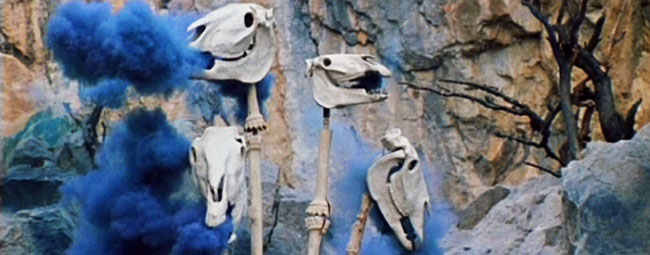
By 1968, Russian director Aleksandr Rou (Vassilisa the Beautiful) had permanently associated his name with cinematic fairy tales aimed at children. To Western audiences he is best known for his film Jack Frost (Father Frost, 1964) because of its inclusion in the canon of Mystery Science Theater 3000; and those familiar with that film may be interested in its follow-up, Through Fire, Water and…Brass Pipes (1968), which reunited Rou with leading lady and ballerina Natalya Sedykh and his favored Baba Yaga, Georgy Millyar. Of course, this is still a 60’s movie aimed at little Russian kids, and in contrast to the extravagant fantasy spectacles of Aleksandr Ptushko, Rou favors pantomime performances, special effects that run hot and cold (here, leaning toward the cold), and sometimes grating musical numbers. Which is not to say that the film isn’t fun – or interesting. In this entry in the Russian Fairy Tale Cinematic Universe (or RFTCU, as I’m coining it), we learn a bit more about Baba Yaga’s family, meet a new fabled villain, cheer for a very intelligent goat, enjoy a significant reference to the legendary hero featured in Ptushko’s film Sadko (1952), travel to an undersea kingdom, and witness a maiden sacrifice on cliffs overlooking the seashore in shots that resemble Clash of the Titans (1981). Of course, the film is bookended by Rou’s familiar babushka (here played by Anastasiya Zuyeva) leaning out a cottage window to tell us the story in rhyme.
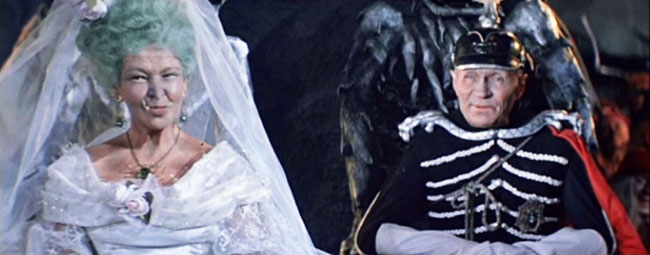
The doomed wedding of Baba Yaga’s daughter (Vera Altayskaya) and Kaschei the Immortal (Georgy Millyar).
The opening is highly unusual for a Rou film. It begins, in fact, as a horror movie – the babushka can wait. A girl (Sedykh) is running through a birch forest clutching her goat. A wolf bares its teeth and lunges at her. The camera zooms into her sweaty face and her saucer eyes and the screen goes red – a very frightening, jarring introduction given the film’s intended audience. Then lushly animated opening credits spell out the title Through Fire, Water and…Brass Pipes. The babushka settles the audience down, and then, in a trope typical of Russian fairy tale films, little birds serenade a dirt-smudged young peasant boy, Vassya (Alexei Katyshev, of Rou’s Barbara the Fair with the Silken Hair). A raven warns of danger, and the birds swoop into hiding, many of them tucking under his overalls. He wards off the wolf, and meets the young woman he’s rescued, Alyonushka, and her goat, whom she’s nicknamed Whitey (well – it’s accurate). The wolf limps off into the woods where it reveals itself to be one of three “werewolf servants” of a sorcerer named Kaschei the Immortal (Millyar). Elsewhere, Baba Yaga (Millyar again) takes her flying mortar to her daughter’s wedding. The mortar sounds like a sputtering airplane and is covered with travel stickers like a vintage suitcase – a bit of anachronistic comedy straight out of Disney’s The Sword in the Stone (1963) – yet she’s still draped in the same old filthy rags, her ogre-like teeth jutting from her mouth. Her daughter (Vera Altayskaya of Rou’s Evenings on a Farm Near Dikanka) is just as ugly, and Kaschei is decked out like a German Kaiser. When a servant of the three-headed dragon Gorynych (featured in Sadko and Vassilisa the Beautiful) presents a wedding gift of apples that remove 100 years from one’s life, the 104-year-old bride doesn’t take a bite, but Kaschei does – looking every bit as old, but now sporting some facial hair. The improbably vain Kaschei declares that he’s too young for his bride now, and must find someone younger; he leaves the wedding in chaos.
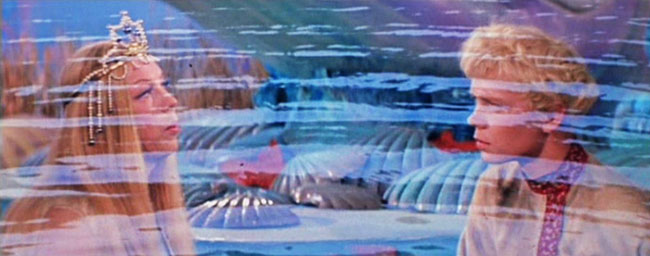
Vassya (Alexei Katyshev) meets a drowned maiden (Tamara Nosova) in the Sea King’s realm.
That bride, naturally, will be Alyonushka, whom Kaschei kidnaps by tricking her into hitching a ride on a magical troika. Vassya, who has fallen in love with Alyonushka, sets off on a quest to find her (Whitey the Goat – who learns a few words of Russian – at his side). His first stop is a castle that’s in flames, the local squad of firemen, who sport roosters on their helmets, demonstrating a general incompetence before Vassya rushes into the fire to save the homely princess. (In a nice touch, the castle keep looks like a balalaika.) The king demands that he wed his daughter as a reward, but when Vassya states that he is engaged to someone else, the king takes the advice of three old women – actually Kaschei’s scheming werewolves – and has Vassya put into a sack and tossed into the sea. Breathing just fine underwater, Vassya meets drowned maidens who have been thrown from the cliffs of a nearby kingdom to satiate the Sea King (Pavel Pavlenko, Father Frost). To torment the Sea King, the drowned girls (played by the Pyatnitsky State Russian Folk Choir) will only perform the classic Russian folk song “Kalinka” and nothing else. Vassya bargains his way out of the king’s submerged palace by offering to teach him to read storybooks; the king rewards him with Sadko’s jacket (Sadko visited the undersea kingdom in the film of the same name). Vassya liberates the maidens and returns them to the surface world. While Alyonushka languishes in Kaschei’s cavern, her only companion a little mouse, Vassya finds himself betrothed to another princess, but he’s shaken out of his spell by Whitey the Goat and escapes back into the woods. At last he defeats Kaschei by following strict, magical instructions: walking backwards toward the Sacred Oak, he digs beneath it and uncovers a black egg, inside which is a needle which he breaks to kill the immortal sorcerer. He’s reunited with Alyonushka, having proven his devotion to her.
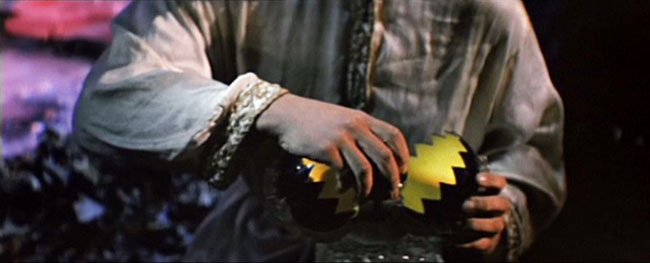
Vassya breaks the egg to discover Kaschei’s hidden weakness.
Though the sets and matte paintings can look flimsy or unconvincing at times – Rou has made better-looking films – this is another imaginatively designed production modeled closely on storybook illustrations. Most effective is the fairy tale logic of the climax, even though its abruptness robs us of a proper farewell to Kaschei or Baba Yaga. Another unusual detail is Kaschei’s method of spying on Vassya’s progress, a ripe apple spinning in a golden saucer that becomes his magical looking-glass. In the Sea King’s realm, Rou overlays rippling water over the image, an effect that is inadequate and yet suitably surreal. The wedding of Baba Yaga’s daughter is a particular delight, the wedding party consisting of fanged witches and monsters, the set dressed with bones and skulls. Through Fire, Water and…Brass Pipes was released on an English-friendly DVD in 2000 from Ruscico, and if you dig through the awkwardly arranged special features you can find some behind the scenes footage, including the rotund Rou overseeing every detail of the set design and some production sketches that would make a beautiful storybook of their own.
